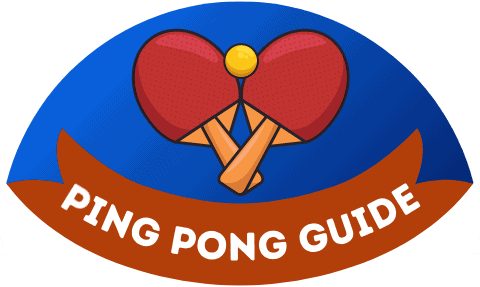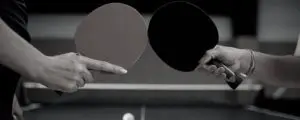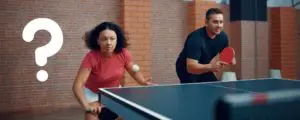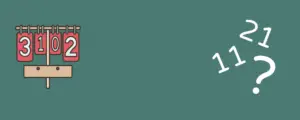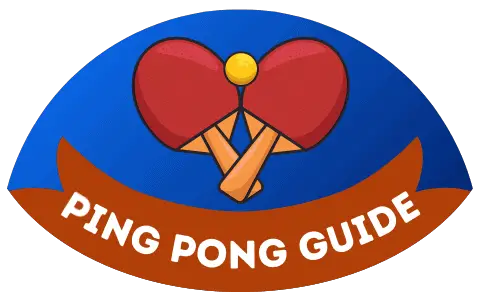Who has the serve? Where is the ball allowed to touch the table? What techniques are allowed when serving? Questions like these often lead to heated discussions, especially in recreational matches. In this post, you will find the right answers and everything there is to know about the serving rules.
Here’s a little overview:
Who serves?
Start of game
Before the match, of course, it must first be decided who may begin serving. In recreational matches, throwing in the ball has become common practice in this regard:
Here one of the players throws the ball with his hand first on his own side of the board and then on the opponent’s. Then play continues normally. Whoever wins this point has serve and the match starts at 0:0.
In official table tennis tournaments, on the other hand, the serve is determined differently:
Officially, the decision is made by lot or, more precisely, by a coin toss. The winner gets to decide whether he or his opponent serves first:
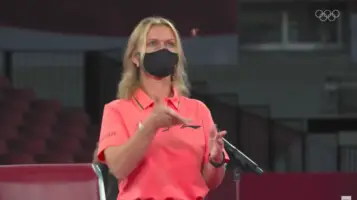
During the game – change of serve
Since 2001, a set only goes to up to 11 points, not 21. Thereby, the serve changes after every 2 points played. So each player always serves twice. Thus, at all even scores (2:4, 3:1, 8:6, etc.) the serve must change. If you ever forget if you have already served twice, this is always a good help.
There is an exception when the score is 10:10, from then on the serve changes after each point.
For games up to 21
Even though games up to 21 are no longer officially played, many recreational players still choose this variation. Here the serve changes after every 5 points, then again after every point from a score of 20:20.
Executing the serve – here’s how
Since there used to be some very contentious serving techniques, the way to serve is clearly regulated. Extra spin on the toss or covering the ball is forbidden. Let’s look into this in detail:
The throw
The serve begins with the ball resting on the open and flat hand. The ball must be above the tabletop and behind the baseline during the entire serve and must not be covered.
Hand positions other than that are not allowed:
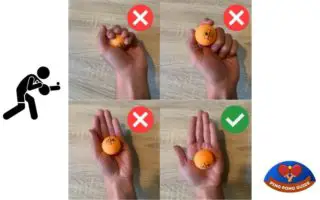
The ball must be tossed at least 16 centimeters (ca. 6.3 in) vertically and without spin in an upward direction. In doing so, it must not touch anything before it is hit.
There are no upward limits to the ball when being tossed. Therefore, many players throw it up to 1-2 meters high to use the higher speed when it falls down for their serve.
Hitting the ball
The ball must be hit above the table while falling down. Then, it must first touch your own half of the table and then the opponent’s half. Again, the ball must not be covered.
Interesting: the ball does not necessarily have to be played over the net, but may also (with enough spin) go past the net.
It does not count if the ball only touches the side of the table. It must hit the top or at least the edge of the tabletop.
There is no rule as to whether you must play the ball forehand or backhand.
Placement of the ball
Unlike often claimed, the ball may be placed anywhere in singles. Thus, one does not necessarily have to serve diagonally.
In addition, you may serve from any position behind the plate. Thus, the following serves are acceptable:
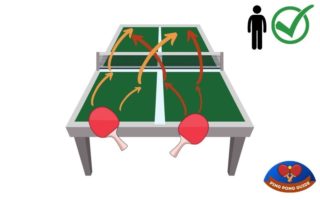
In these cases, the serve must be repeated
There are several reasons why a serve must be repeated. In table tennis, this is called a “let”. Reasons can be as follows:
- The ball touches the net or one of the net posts on an otherwise correct serve. It does not count if the ball subsequently goes out of bounds.
- The return player was not ready when the serve was made. Important: The returning player must not try to hit the ball while doing so.
- A player was unable to serve or return the ball correctly
- A stoppage of play by the referee
Serving in doubles – special aspects
In doubles, there are a few special things to know about the serve. Here is a brief summary:
Who serves in doubles?
After deciding which team will serve first, the serving team must agree on who will serve the first two serves. In the same way, the other team must decide who will take the return.
When the serve changes, the previous return player then serves and the partner of the server becomes the returning player.
Differences in serving
Unlike in singles, the serve in doubles may only be made diagonally from the right side of the plate. The centerline still counts towards this.
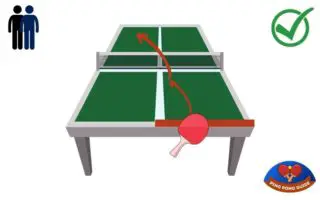
Quick Q & A
If there are still points you’re not sure about when it comes to serving, I’ve collected here some more answers to common questions that always lead to discussions:
What happens if you don’t hit the ball, on serve?
If the ball falls to the ground after being thrown without touching it, it counts as a fault. The opponent gets one point. The serve may not be repeated in this case.
What happens if the ball goes back to your side without being touched by the opponent?
Maybe it has happened to you before: With enough spin, the ball can change direction on its own and land back on your site without being touched by your opponent.
On serve (and also in the normal course of play), you win the point in this case.
Are you allowed to spin the ball when you toss it up?
As described in the article, it is not allowed to apply additional spin to the ball when tossing it. Disregarding this rule is considered a fault.
Can the racket be below the table when serving?
As long as the ball is played above the tabletop, the racket may be below the table. Only the ball must always be above.
Can the ball touch the edge of the table when serving?
If the ball hits the edge in table tennis, it is often annoying as it bounces off it unpredictably. Nevertheless, as in the normal game, this is also allowed in the serve.
If, however, the ball hits the side of the table, it is considered a fault.
End of discussions
I hope I was able to explain the serving rules well with this post and resolve a discussion or two. Once the question marks are out of the way, you can finally just focus on the game again and most importantly:
Have fun!
